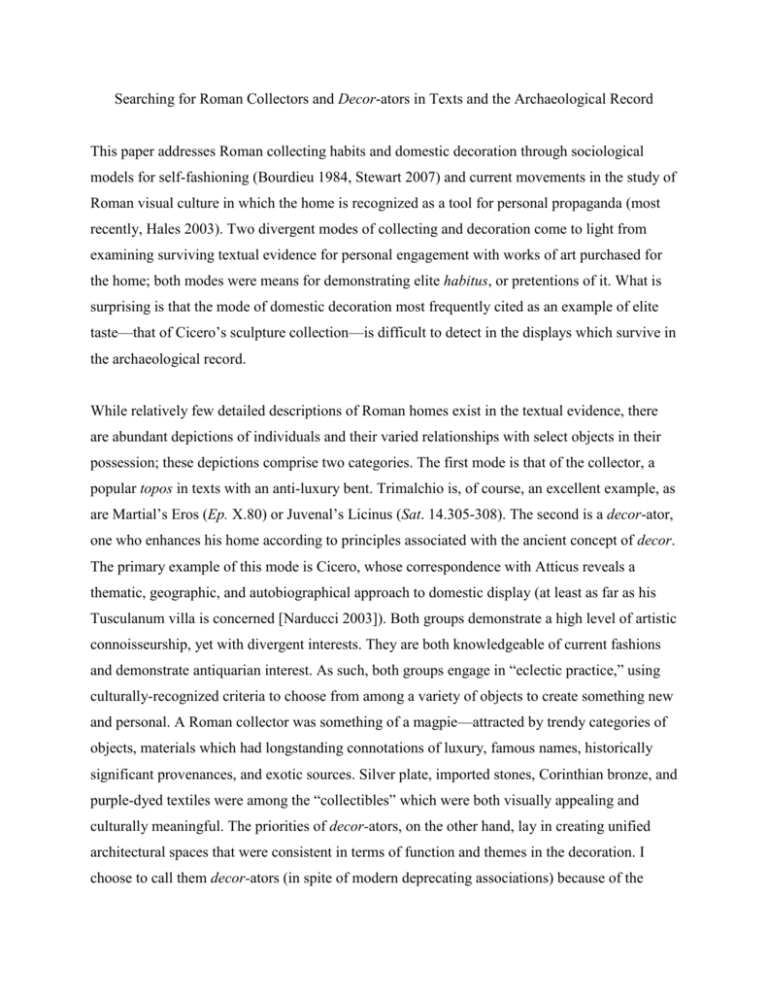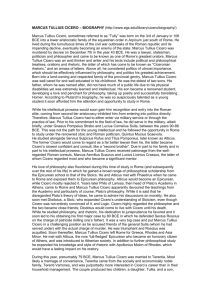Abstract
advertisement

Searching for Roman Collectors and Decor-ators in Texts and the Archaeological Record This paper addresses Roman collecting habits and domestic decoration through sociological models for self-fashioning (Bourdieu 1984, Stewart 2007) and current movements in the study of Roman visual culture in which the home is recognized as a tool for personal propaganda (most recently, Hales 2003). Two divergent modes of collecting and decoration come to light from examining surviving textual evidence for personal engagement with works of art purchased for the home; both modes were means for demonstrating elite habitus, or pretentions of it. What is surprising is that the mode of domestic decoration most frequently cited as an example of elite taste—that of Cicero’s sculpture collection—is difficult to detect in the displays which survive in the archaeological record. While relatively few detailed descriptions of Roman homes exist in the textual evidence, there are abundant depictions of individuals and their varied relationships with select objects in their possession; these depictions comprise two categories. The first mode is that of the collector, a popular topos in texts with an anti-luxury bent. Trimalchio is, of course, an excellent example, as are Martial’s Eros (Ep. X.80) or Juvenal’s Licinus (Sat. 14.305-308). The second is a decor-ator, one who enhances his home according to principles associated with the ancient concept of decor. The primary example of this mode is Cicero, whose correspondence with Atticus reveals a thematic, geographic, and autobiographical approach to domestic display (at least as far as his Tusculanum villa is concerned [Narducci 2003]). Both groups demonstrate a high level of artistic connoisseurship, yet with divergent interests. They are both knowledgeable of current fashions and demonstrate antiquarian interest. As such, both groups engage in “eclectic practice,” using culturally-recognized criteria to choose from among a variety of objects to create something new and personal. A Roman collector was something of a magpie—attracted by trendy categories of objects, materials which had longstanding connotations of luxury, famous names, historically significant provenances, and exotic sources. Silver plate, imported stones, Corinthian bronze, and purple-dyed textiles were among the “collectibles” which were both visually appealing and culturally meaningful. The priorities of decor-ators, on the other hand, lay in creating unified architectural spaces that were consistent in terms of function and themes in the decoration. I choose to call them decor-ators (in spite of modern deprecating associations) because of the presumed concern with suitability of setting and subject-matter. The antiquarian aspect of this decorative mode is clear, yet it is even more evidence of an enhanced level of erudition because of its specificity, suggesting first-hand experience with renowned places. Collectors, in spite of the general disparaging tone used to describe them in the ancient sources, were also indeed antiquarians; their knowledge of materials and makers reveals a certain level of artistic erudition. Both these types of connoisseurial sophistication functioned as cultural currency among the elite (and perhaps even sub-elite). Both collectors and decor-ators participated in shared cultural practices which would have asserted an individual’s position and reputation among his peers, even if those two groups’ practices and resulting displays were different. Both collectors and decorators used their possessions for symbolic self-completion; both demonstrate a desire to project self-image and personal experience through these domestic displays. Modern scholars tend to appreciate the apparently intellectual practices of the decor-ators over those of the collectors, who seem crass and ostentatious. This is, of course, as much of a function of the moralizing ancient authors as our modern prejudices. When searching for evidence of collectors and decor-ators in the archaeological record (e.g. the domus and villas of the Bay of Naples), a surprising conclusion emerges: the latter group is nearly invisible while there are many more examples of the former. Collections of “collectibles” are far more prevalent than those sculptural displays, for example, which demonstrate any sort of consistency of subject-matter or geographical allusion. The collections of the Villa dei Papiri at Herculaneum, or Villa A at Oplontis—arguably elite Roman residences—demonstrate a thematic eclecticism which does not correspond to the purportedly aristocratic mode of decor-ation. In light of this, it is perhaps prudent to deemphasize Cicero as a model when addressing archaeological examples of domestic display. Select Bibliography Bounia, Alexandra. 2004. The Nature of Classical Collecting: Collectors and Collections. Hampshire. Bourdieu, Pierre. 1984. Distinction. Cambridge. Mattusch, Carol. 2005. The Villa dei Papiri at Herculaneum. Los Angeles. Hales, Shelley. 2003. The Roman House and Social Identity. Cambridge. Narducci, Emanuele. 2003. “La memoria della grecità nell’immaginario delle ville ciceroniane.” In Memoria e identità, edited by M. Citrioni, 199-148. Firenze. Neudecker, Richard. 1988. Die Skulpturen-Ausstattung Römischer Villen in Italien. Stewart, Susan. 2007. On Longing. Durham, NC. Von Stackelberg, Katharine T. 2009. The Roman Garden: Space, sense, and society. London/New York. Wallace-Hadrill 2008. Rome’s Cultural Revolution. Cambridge.









